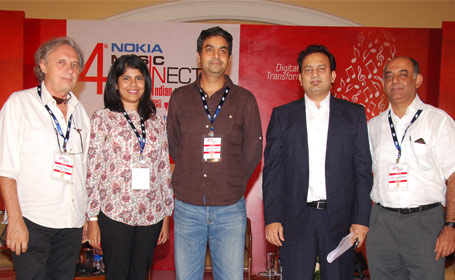MUMBAI: On day one of Radioandmusic.com’s fourth edition of Nokia Music Connects (NMC), industry leaders discussed the issue of licensing music in the age of digitalized music. The session theme – ‘The New Breed’ was moderated by OnMobile content head Atul Churamani, and comprised of Disney UTV – Audio & Music head, Lavania Tauro, Eros Group CGFO Kamal Jain, SaReGaMa India business head Adarsh Gupta and Universal Music Publishing MD Achille Forler.
A predicament that the two major components of the music industry – the producer and the music label face is whether to sell off the rights of the music, or whether to monetize it themselves. As rapid digitization of music opens potential of monetization, the Indian music industry currently worth approximately USD 1 billion, has lately woken to the potential of music rights as a major revenue earner.
The earlier business practice was for the producer to sell the whole or partial rights to music labels for a lump sum. But in recent years, the producers have retained the rights or some part for themselves.
Music rights can sell for as low as Rs 50,000 to tens of millions of rupees, depending on the producer/ banner, the cast, the artists involved and the quality and number of songs. Currently, music can be monetized mainly through physical sales which is the traditional but rapidly vanishing method, and through digital which is a rapidly expanding market that needs to be mapped for full exploitation and publishing, which needs good global alliances and partners as the market expands beyond national boundaries.
“We don’t want to assign our music rights for perpetuity. In case we license it out, it’s usually for 3 to 4 years. There are more ways to use content today although a one-time payment for the content might mean more revenue. Giving away rights also curbs our creativity,” UTV Audio & Music head, Lavania Tauro said.
This works well if the producer is also a broadcaster like UTV and has a dedicated team to monitor the revenue stream. The dedicated team enjoys the option of outsourcing a part of work that it cannot handle.
“Retention of licensing goes against our business fundamentals. But the increase in producers retaining the rights of their music is not large and there are many business opportunities for labels to acquire rights, especially in regional markets,” SaReGaMa India business head Adarsh Gupta said. According to Gupta, 30-35 per cent of all music played across TV channels belong to SaReGaMa. The label’s catalogue is worth approximately Rs 20 billion.
Eros follows a business model wherein a dedicated team looks after its catalogue of songs in the physical and digital spaces to monetize the rights. “But we do not yet have an end-to-end network for our mobile platform, so we need to partially outsource our work” Eros Group CFO Kamal Jain said.
“What has changed in the last seven years has been the monetization of music,” he added.
Another challenge brought about by digitization and increasing awareness of the potential of copyrights is the amount of processing work it demands. Even labels like T-Series have outsourced the publishing rights processing work to Universal Music Publishing.
The panelists agreed that the new amended Copyright Act which allocated up to 50 per cent of the revenues of monetized songs to the composer and lyricist, would hardly affect the deals made by producers, artists and labels regarding copyrights of songs.
“What is ultimately important is the quality of the content which is often ignored. There is no way that a good composer can deliver quality music for say 10 films in a row. In the future, television channels and producers will let go off their publishing rights and concentrate on their work,” Universal Music Publishing MD Achille Forler predicted.
